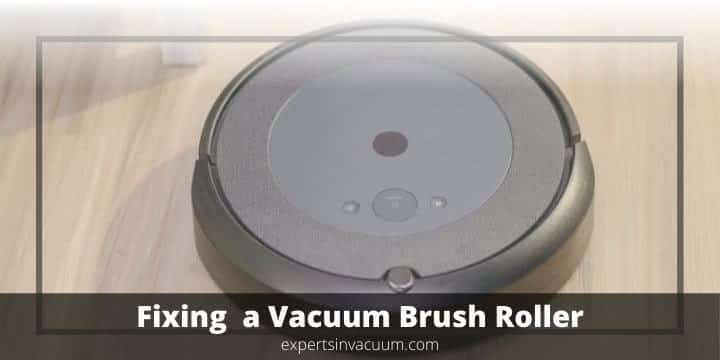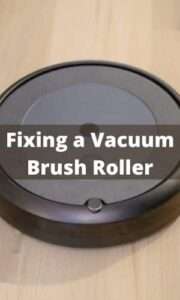A vacuum cleaner is the most efficient tool for cleaning your home, and every part of the machine is equally important. Consider the vacuum brush roller, which greatly aids in the removal of dirt and dust.
The brush roller is a vacuum attachment that consists of a row of bristles and, in some cases, beater bars that agitate the dirt in the carpet. When the brush roller ceases to function properly, the vacuum cleaner fails.

That occurs when the brush does not spin. The issue arises when various particles clog the vacuum roller brush, causing it to stop spinning and reducing the vacuum’s performance.
However, this is not a long-term issue that necessitates the purchase of a new vacuum. You can repair the brush roller at home in a few simple steps.
In this post we will cover:
- How to Fix a Vacuum Brush Roller: A step by Step Guide
- When should I use the vacuum brush roller?
- Why is the brush roller on my vacuum not spinning?
- How do I know if my brush roller needs to be changed?
- How should I maintain my vacuum cleaner?
How to Fix a Vacuum Brush Roller: A step by Step Guide
1. Find the perfect place: that is a place that you can work comfortably without minding the filth, dirt, and dust that will cover the area.
Cover the area you will be working on with a newspaper or dirty cloth to minimize the amount of dirt that will get on the space.
Place your vacuum cleaner on the side so that you can access the bottom. That is where you will find the vacuum brush roller.
2. Examining the vacuum roller brush and belt: consult your vacuum’s instruction manual so that you can understand how the vacuum brush roller is to be taken out. The brush will come out if you slide it out or pop it out.
However, you need to first remove the access plate located on the vacuum’s bottom so that you can reach the vacuum brush roller. You will require a screwdriver to remove the screws holding the plate in place.
Before removing the brush, inspect the vacuum brush roller and the vacuum belt for any damage. You will need to change the belt if it has been damaged and use your hand to remove any accumulation of hair and dust on the roller if it is not spinning.
Also, check the bristles of the brush roller to make sure that they are not extremely worn out. The bristles should feel a bit rigid when you roll your hand over them.
The rigidity is what enables the brush to provide the agitation required to pull trapped dirt from surfaces.
If the vacuum brush roller is broken or visibly worn out and requires replacement, you do not have to clean it. If one of these situations or both is the case, just proceed to replace the brush roller.
3. Removing built-up hair and dirt: after removing the brush roller from the vacuum, begin the cleaning process. Dampen a sponge and use it to clean the brush roller and its bristles.
If the brush is not spinning, you will find plenty of strands, hair, or floss jammed into the bristles and wrapped around the roller. Try to undo any tangles with your hand and cut off any strands of hair with a pair of scissors.
When the vacuum brush roller is drying, use this opportunity to clear out any trash blocking the vacuum’s bottom, which can reduce the unit’s suction capacity.
Assemble your vacuum after eliminating all the waste and the parts have dried. If this has not solved the issue with your brush roller, proceed to the fourth step.
4. Fix the vacuum brush roller: you will need to take this step if you have cleaned the vacuum brush roller and it is still not functioning properly. If you come across a broken element during the cleaning process, you have to repair it or change it if it cannot be repaired.
Find a spot to fix the vacuum brush roller without stressing over the dirt that will get into your house. Look for a flat surface that will allow you to work comfortably. Make sure that your unit is not connected to a power source to avoid any electrical accidents.
Take out your vacuum brush roller and examine it. Usually, you will find two significant problems with the brush. The first is worn out strips of the brush and the second is a damaged brush roller.
5. Replace the brush roller: If you notice any visible damage or wear to the bristle strips of the vacuum brush roller, you can easily replace them because they slide out of the roller easily.
Check the bearings on both ends of the brush roller to ensure that they are usable and intact so that the brush spins properly. You can inspect the bearings by turning the vacuum roller in its position with your hand.
If the vacuum brush roller looks badly aligned or feels difficult to spin, it means that the bearings or spindles at the end of the brush roller may be worn out or broken. If this is the case, get a new brush roller to replace the old one.
6. Replace the driver belt of the brush roller: a broken or detached driver belt will prevent the vacuum brush roller from spinning. Locate the belt once the brush roller is removed and you will see where it came off from its place if it is detached.
Replace the belt in its position. Find a replacement if the belt is broken.
Conclusion
A vacuum brush roller performs the majority of the cleaning work in a vacuum, and as a result, its significance cannot be overemphasized.
However, there are some common problems that can cause the vacuum roller brush to stop spinning, reducing the effectiveness of the brush and causing it to become ineffective.
A buildup of dirt, wear and tear, and damage to the brush roll could all be contributing factors. These issues can be resolved quickly and easily at home by following the instructions provided above.
It does not necessarily imply that your vacuum has reached the end of its useful life. Alternatively, if the vacuum brush roller has become damaged beyond repair, it is necessary to replace it.
FAQs
When should I use the vacuum brush roller?
The vacuum brush roller is the best when it comes to vacuuming your carpet, but do not use it on bare floors such as wood or tile because it will scratch the floor. It can damage hard floors and some area rugs.
The roller is designed to work on carpets because its bristles are meant to go deep into the carpet fibers to remove the debris and dirt embedded therein. Set the height adjustment to the right level to get the best performance.
The vacuum brush roller has an on and off switch, giving you the option to turn it on when cleaning carpets and off when cleaning hard floors. Having this option increases the usability of your vacuum.
When you vacuum hard surfaces, the brush roller will push debris and dust away from the machine before they can be suctioned. Therefore, turn off the brush roller when cleaning hard floors and the vacuum will only suction what you are cleaning.
The on and off switch of the brush roller allows you to transition between carpets and hard floors easily. It also means that you will only use one vacuum on these surfaces, but the settings will be different.
When you are using the hose or other vacuum accessories, turn off the roller to avoid beating on one spot of the hard floor or carpet.
Why is the brush roller on my vacuum not spinning?
1. A detached or broken belt: when the drive belt of the brush is broken or detached, it will prevent the roller from rotating. Inspect the belt once you have removed the vacuum brush roller. When the belt spins, it helps to rotate the brush roller.
2. Jammed brush roller: when hair gets tangled in the brush roller or other debris wraps around it, they will cause the brush to be jammed. Remove all the debris to get it working again. Cut the hair with a pair of scissors and remove other debris by hand.
3. Tripped brush roller motor: for canister vacuums, the brush roller motor has an overload reset button that trips if the brush roller overheats. If this is the case, allow the brush roll motor to cool and then press the reset button to reset the overload.
If the motor overload keeps tripping, the brush roller motor will need to be replaced because its wiring will be damaged, causing it to overheat and trip the overload.
4. Lazy carpet layers: some vacuums, such as Hoover, suck up loosely laid carpets, which in turn lock the brush roller. That happens if your carpet is loosely laid. When the roller is locked, the belt will turn until it burns through.
How do I know if my brush roller needs to be changed?
When the bristles of the brush roller have been subjected to excessive wear and tear, the roller will no longer function properly and will need to be replaced. The brush is responsible for the majority of the cleaning work and will eventually wear out.
If you use your vacuum regularly, it is recommended that you replace the brush roller on a more frequent basis. Check the condition of your brush roller on a regular basis to ensure that the bristles are in good working order.
If the brush roller appears to be worn out and loose, it should be replaced.
How should I maintain my vacuum cleaner?
There are ways of keeping your vacuum cleaner in good working condition. These include:
1. Unclogging your vacuum cleaner: Regularly check for clogs in areas that are prone to clogging in your vacuum, such as the hose, and remove them. Also, empty the dust container or dirtbag often because when they are full they will affect your vacuum’s performance.
2. Replacing the filters of the vacuum: Most units have a HEPA vacuum that is removable. Some of the filters are washable, while others just need to be changed. The filters reduce the suction power of the machine when they are dirty.
Your vacuum manual will inform you about the type of filter you have, when to change it, and how to remove it. The changing or cleaning of the filters also depends on how frequently the vacuum is used.
The washable filters are washed by hand with a drop of dishwashing liquid and warm water. Rinse the filter well and leave it to dry for 24 hours before putting it back into the vacuum.
3. Checking the beater brush: The brush combs hair, lint, and threads out of the carpet, and any malfunction will affect the cleaning performance. When threads and hair are entangled in the brush, the bristles of the brush will be less effective.
Inspect the brush every week and cut any debris wrapped around it with a pair of scissors or a knife. Check the height of the brush to ensure that it matches the floor type being cleaned.
The highest setting is for shag rugs, while the lowest setting is for low-pile carpets and bare floors. Applying the low setting on medium to high-pile rugs or carpets will wear out the brush.
